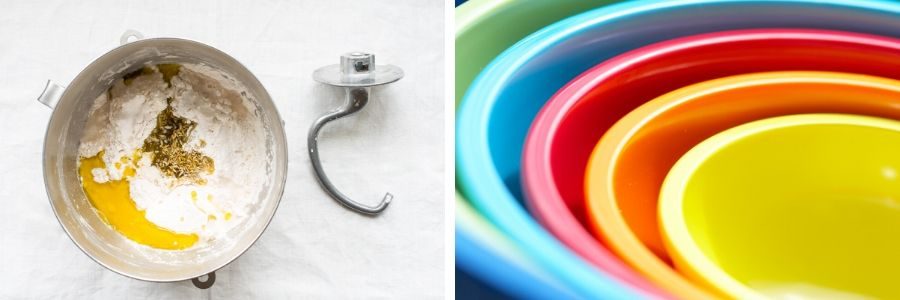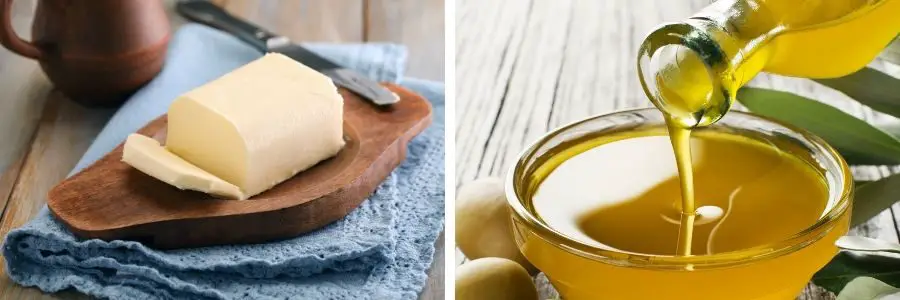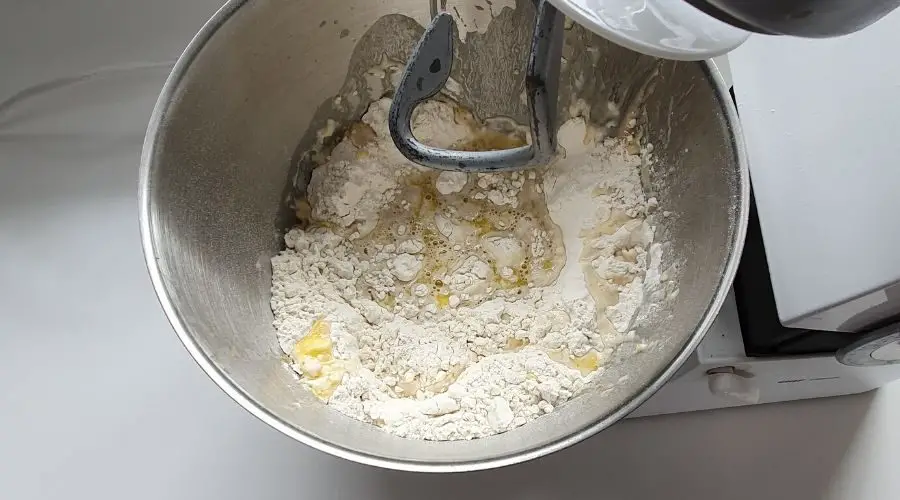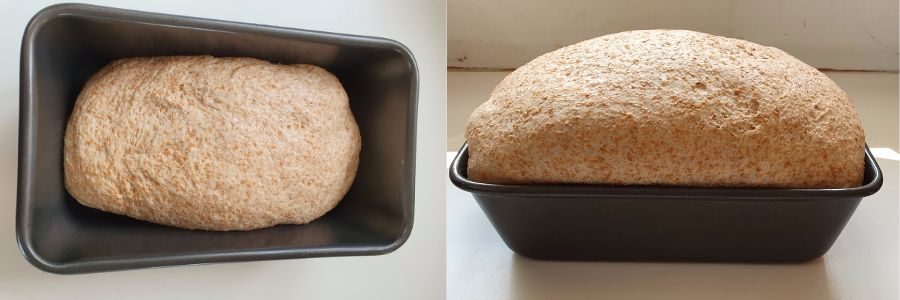The thought of making bread from scratch can be daunting for beginner bread makers. There are so many different types of bread and processes to learn along with new ingredients and equipment.
But it doesn’t have to be difficult, people have been making bread as a staple food for thousands of years and you can too!
In this in-depth post, I want to show you bread making tips and techniques which will help you get the best bread making results.
1. Use good bread making ingredients
At the time of writing this article, and following lockdown, it has become increasingly difficult to buy bread flour in local supermarkets.
There are some amazing flour producers using traditional milling methods across the UK and many of them sell flour online or can be found on Amazon.
Finding a good flour that you like is important for bread making, this is because some flours absorb more water than others which can have an impact on the end result.
Here are just a few good flour brands which produce a range of bread flours:
- Doves Farm
- Marriages
- Shipton Mill
- Wrights flour
See our Bread Flour Directory here for links to many UK producers.
I would also recommend using a good quality sea salt containing natural minerals such as Maldon or Anglesea Sea Salt.
Find out more about bread making ingredients and where you can buy them here.
2. Basic bread making equipment
If you’re a beginner bread maker you don’t need much equipment to get started, but there are some essentials that you’ll need, including:
- Large mixing bowl/s – big enough to mix the dough and for it to double in size when it rises.
- Dough scraper – very useful for scraping dough out of a bowl, dividing dough and scraping dough from work surfaces.
- Bread tin – essential for making tin shaped loaves.
- Large baking tray or sheet – you will need one of these if you plan to make a shaped loaf or bread rolls.
Once you get to grips with bread-making, you might want to consider expanding your equipment kit, such as a pizza sone or a dough peel.
Find out more about bread making equipment and their uses here.

TIP: Not sure if you have all the necessary bread baking equipment at home? Check out my recommended picks below (Amazon links):
-
- Scale: Nicewell 22lb Digital Kitchen Scale
- Mixing Bowls: OXO Stainless Mixing Bowls Set
- Pastry Scraper: OXO Stainless Pastry Scraper
- Loaf Pan: OXO Non-stick Loaf Pan
- Kitchen Thermometer: ThermoPro Digital Thermometer
- Stand Mixer (optional): Kenwood Kmix Stand Mixer
3. Best bread recipe for beginners
If you’re just starting out on your bread making journey and you’re wondering which bread recipe is best to gain an understanding of how things work, I would recommend a basic white loaf recipe.
This way you can experiment with yeast and the basic principles of rising and proving dough.
If you would prefer to make bread without yeast to begin with, try this quick and easy soda bread recipe.
4. Making time for bread making
Although most bread recipes don’t require much hands-on time, most doughs will need plenty of time to rise and prove.
Cutting corners when it comes to time will generally result in the bread going wrong.
Bread making is best done on a day when you have time to go back to it in an hour or two at each stage.
If you plan to make bread for a certain meal, then allow about four hours for all steps and until the bread can be eaten.
I know this sounds like hard work and a long time, but you only need to spend a small amount of time doing any hands-on work, the rest of the time the dough is doing its own thing.
5. Dried yeast or fresh
In most cases in cooking fresh is usually best, but in the case of yeast, dried yeast generally produces much better results than fresh.
Here are some good reasons to use dried yeast for making bread:
- It’s much more readily available and can be found in most small supermarkets.
- It stays fresher for much longer, especially if you use sachets.
- You don’t need to prepare or activate dried yeast.
- Dough using dried yeast will rise quickly and evenly.
I recommend using Allinson’s easy bake yeast, which you can buy in sachets or small tins.
If you don’t make bread very often, I would advise buying the sachets because the tinned yeast will be very slow in rising if the tin has been open for a while (even if it’s still in date).
I find that I get much better performance from yeast in sachets, it’s always more active and gives a better rise.
For more information on this topic, you might find the following article helpful:
Keep salt and yeast separate
This was a technique made famous by Paul Hollywood on Bake Off and it’s something I always do.
Yeast which is in direct contact with salt can be killed off or performance can be affected.
Although they do come into contact with each other once the ingredients are mixed together, they are diluted throughout the mix so there’s less of an impact.
Dough which is too salty can result in a poor rise due to underperformance of the yeast. Too much sugar in the dough can also have the same effect.
6. Water in bread making
Water in bread making is a very important part of the bread-making process because it’s needed for gluten to form and the bread to rise.
It’s also essential for getting the right dough consistency.
What is the water to flour ratio in bread making
Generally, the water to flour ratio is about 5 parts flour to 3 parts water, so for a standard white loaf that’s around 300ml of water per 500g of flour.
This is only a guide because there are certain factors which can affect how much water is needed for the dough, including:
- The type of flour – each flour is different and some absorb more water than others, by sticking to flour you like and know you can learn the water ration which works best for you.
- The outcome you’re looking for – a wetter dough is better than a dough that is too firm because it rises better and will result in a lighter bread that isn’t dense.
- Sticky dough – a stickier dough is best, but it can get messy when you’re kneading if you have a dough hook this saves sticky hands and allows you to add a little bit more water.
- Wholemeal and brown flours – flours containing the wholegrain are more thirsty than white flours, I generally use 350ml water per 500g in this case.
As a general rule, you will need from 300 to 350ml of water per 500g of flour. If you mix the dough and it looks dry and flaky once it’s come together then add a bit more water to the mix.
The best water temperature for bread making
The best water temperature for bread making is around 20-25°C/68-77°F. This is tepid or just warm.
If water is cold it will produce a very slow rise and affect the performance of the yeast. Water which is too hot or warm could kill the yeast or make it rise too quickly.
To get warm water, I like to either use cooled boiled water from the kettle or mix hot water from the kettle with cold water in a jug.
I always make a bit too much in case I need to add extra water to the dough mix.
7. Which fats are best in bread making
Adding fat to the dough helps to produce bread with a soft texture that lasts a bit longer. The best fats to use in bread making are softened butter or olive oil.
I tend to use butter for a standard loaf and roll recipes and oil for Italian bread and pizza.
Olive oil is also good for greasing bread tins and using on work surfaces for kneading and shaping. Using flour for kneading can make the dough too dry and heavy.
If you prefer not to use fat in your bread, then it’s fine to leave it out of the recipe.
For more information on using fat in bread making, you might find the following post useful:
What does adding fat do to bread dough

8. Using milk in bread making
Using milk in bread making helps to create a soft loaf with a slightly sweet flavour.
You can replace some or all of the water with milk which has been warmed slightly to it’s just warm to the touch.
You can also replace fat with the same amount of milk if you prefer.
I find that when using all milk or a high proportion (to replace water) the dough tends to rise quite slowly, I recommend more rising and proving time if you’re using milk.
9. Learning to knead by hand
Even if you have a dough hook, learning to knead by hand is a useful technique to learn.
It helps you to understand how the dough changes as the gluten is stretched and what it should be like when it’s ready for rising.
You don’t need to be an expert in kneading to get it right and you can develop your own style that works best for you.
By turning, folding and stretching the dough, you will be doing all of the right things to help the gluten develop and for the dough to become elastic.
If you’re kneading by hand then it will take a bit longer than if you’re using a machine. 10-15 minutes of hand kneading is usually enough and it’s a great workout too!
The dough will become easier to handle as you knead it and will start to develop a sheen with a blistered effect once it’s ready
10. Kneading dough with a hook
If you don’t like kneading by hand and you prefer using a machine then a dough hook on a stand mixer is a good option.
A dough hook does all the hard work including mixing and kneading. All you need to do is add the ingredients and remove the hook and then cover and rise.
A dough hook kneads the dough quicker than you could by hand, I generally set a timer for about 8 minutes for most doughs, maybe a bit longer for wholemeal.
It’s great for doughs where you need a sticky or wetter mix that would be difficult to knead by hand. It also allows you to up the water in your recipe for a better performing dough.
If you want to find out more about making dough using a bread hook, you might like to read my post how to make bread using a dough hook.

11. How to rise dough
Rising dough is an important part of bread making which needs to be given the time it deserves for optimum results.
Once the dough has been kneaded it needs to be placed in a large mixing bowl which has space for it to double or even triple in size.
The first rise usually takes at least an hour and could take up to two or three.
The longer the bread takes to rise, the more flavour it will have, so it’s best not to rush things too much if you have the time.
This is one of the reasons that sough dough is so tasty because it rises and proves for much longer than a standard dough.
You can also slow down the rising process by placing it in the fridge overnight for extra flavour.
Where should you put dough to rise
Dough should have no problem rising if the room is a normal temperature (not too hot and not too cold).
If the room is very cold, the dough may struggle to rise for some time and if it’s too hot it might rise too quickly.
In a situation where the room is too cold, try moving the bowl somewhere warmer such as an airing cupboard.
Another trick you can try is to preheat the oven to around 50-80°C and then turn it off, place the bowl in the oven with the door open slightly.
If the room is very warm, keep the bowl somewhere cool such as by a window and make sure it’s not in direct sunlight.
If you’re lucky enough to own a proving oven then you can create a constant warm temperature throughout the rising process.
If you want to find out more about rising dough, you might find the following article helpful:
How to make bread rise more every time
12. How to shape dough
Shaping the dough after the first rise is an important step in the bread-making process.
Shaping the dough the right way before the dough is proved will help the dough keep its shape and create a strong structure.
Dough that hasn’t been shaped properly will flop and spread on a baking sheet rather than rise up high.
Once the dough has risen for the first time, remove it from the bowl and onto an oiled surface.
Press the dough down to flatten and remove any large air bubbles and fold the dough over on its self until the top of the dough is smooth and tight.
If you’re making a round loaf fold into the middle and use the side of your hands to shape into a round.
If you’re making a tin loaf or bloomer, follow the same process but form into an oblong shape.
Make sure the bread is seam side down on the baking tray or within the bread tin.
If you’re making sourdough using a proving basket keep the seam side up as you will be tipping the dough out onto a baking sheet and the bottom will become the top.
13. How to prove dough
Proving dough correctly is a vital part of the bread-making process in order to create the best bread texture.
Proving or proofing means rising the dough for a second time once the dough has been formed into its final shape.
Dough is shaped and then proved in a bread tin or if you’re making a cob loaf or bloomer, on a baking sheet or tray.
It should be covered with a cloth or placed inside a bag that can’t stick to the dough. If the dough sticks, it will collapse when you unstick the dough from the covering.
How long does it take to prove bread dough?
Proving dough properly will take at least an hour or maybe longer depending on the dough consistency and room temperature.
It’s important to make sure the dough is proved and enough before you place it in the oven.
How can you tell if bread dough is proved?
You can tell if the dough is proved enough by gently poking your finger into the dough, if the dent you’ve made stays there, it’s not ready.
If the dough quickly springs back most of the way, then it’s ready to be baked.
It should have also at least doubled in size, see an example of before and after proving in the image below:

What happens if you over or under prove bread?
If dough is under proved, it will result in a dense and flat loaf (a bit like a brick). This is why proving the dough correctly is so important.
If the dough is over proved it will be very fluffy in texture and it might start sinking if it rises too much.
For more information on proving dough, take a look at the following article:
What is Dough Proving (proofing) and How to do it Properly
14. Slashing bread dough – how and why do you do it?
Slashing bread dough in various patterns has become really popular amongst bakers and some have made it into an art form.
Not only does dough slashing make the bread look really good, but it also helps it to expand and achieve a greater rise as it bakes in the oven.
For best results slash the dough with a sharp serrated knife after it’s proved (for the 2nd time). I like to leave the dough to recover for 10 minutes or so before I place it in the oven.
For more elaborate patterns you may want to invest in a bread lame which is a type of razor which creates a neat slash in the dough.
Using a sharp knife which isn’t serrated tends to drag the dough and can make it collapse.
It’s best to use a quick action so you don’t drag the dough, if the dough is shaped well and firm it should be easier to slash.
You can read my full article on slashing bread via the link below:
How to score or slash bread and why we do it
15. Oven baking bread
Most traditional bread recipes need a fairy hot oven to achieve a good crust.
Each oven varies and a fan oven will give an evenly spread higher heat whereas an oven with no fan may give more of an inconsistent heat.
The recipes on this site are assuming fan oven temperatures, so if you’re not using a fan oven or you have an Aga, you may need to adjust the temperature accordingly.
Make sure the bread has plenty of space above because it will continue to rise as it bakes and if it’s too close to the cooker element the top of the bread could burn.
To get a crispy base to the bread or more heat into the oven you can use a pizza stone. Put the stone in the oven when it’s cold and heat up to avoid cracking the stone.
Place the bread directly onto the stone using a dough peel or place the baking sheet on top.
How do you know when bread is baked properly
The first sign your bread is ready is that it’s turned a rich golden colour without burning. If the bread is still pale, it won’t be ready yet.
The outer crust should be crispy and the bread should sound hollow when you knock the base with your knuckle.
Do you need steam when baking bread?
Whether or not you need steam when baking bread really depends on the finish you’re looking for.
Steam helps to create a shiny and almost bubbly finish with a crispy crust.
Using steam in the oven creates moisture which helps the bread to expand and grow in the oven as it cooks and before it forms a crispy crust.
You can create steam in your oven by half filling a deep baking tray with hot water before you place the dough in the oven. The water will evaporate into steam as the bread bakes.
For more information on steam in bread baking, you might want to take a look at the following articles:
What does steam in the oven do for bread?
Spraying water on bread dough before baking
TIP: Not sure if you have all the necessary bread baking equipment at home? Check out my recommended picks below (Amazon links):
-
- Scale: Nicewell 22lb Digital Kitchen Scale
- Mixing Bowls: OXO Stainless Mixing Bowls Set
- Pastry Scraper: OXO Stainless Pastry Scraper
- Loaf Pan: OXO Non-stick Loaf Pan
- Kitchen Thermometer: ThermoPro Digital Thermometer
- Stand Mixer (optional): Kenwood Kmix Stand Mixer
Summary
I hope this post has helped you to understand some fundamental bread making techniques and tips.
All of these things put together may seem a lot to take in, but once you get to grips with the basics bread making becomes so easy with practice.
